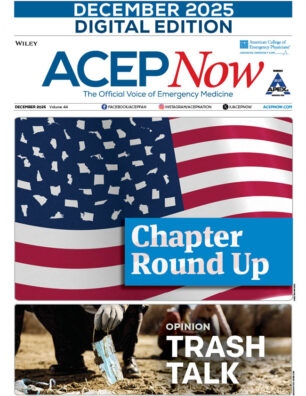LAS VEGAS–As the only pharmacologist to speak at this year’s ACEP conference, Bryan D. Hayes, PharmD, DABAT, FAACT, believes it was “a tremendous testament to the collaborative team work we have in emergency medicine,” he said. The clinical pharmacist at the Massachusetts General Hospital in Boston perhaps initially raised the blood pressure of attendees by posting a highly-technical pharmacology schematic as a joke before turning his focus to two old medications utilized today for major and minor trauma treatment, sedation and pain management.
Explore This Issue
ACEP16 Monday Daily NewsTranexamic Acid
Tranexamic acid (TXA) has been around for decades. An “antifibrinolytic,” TXA is an anti-clot buster with possible anti-inflammation effects. A randomized, placebo-controlled 2010 trial of 264 hospitals in 40 countries (not including the United States) found that patients who were given TXA had a significantly improved survival rate compared to patients who received the placebo.
“Yet, most trauma bays are still not using TXA,” Mr. Hayes said.
Tranexamic acid has gotten a bad rap for increased clotting events. However, the more current studies have shown no risk, he noted. A subsequent trial that studied treatment time found that, if it’s to be used, it must be administered within three hours of the injury.
In the past, another concern has been for patients who receive massive blood transfusions. Yet, a trial of military combatants in Afghanistan found the benefits of TXA were even more pronounced among the severely wounded.
“None of the trials found an increased risk of clotting,” Mr. Hayes said. Although there have been studies to show a higher mortality for trauma patients treated with TXA, Mr. Hayes said that many of these patients were so much sicker and at an increased risk of death—even more than those in the combat study.
As an added bonus, TXA is inexpensive—around $17.
If emergency physicians still experience push-back on TXA, Mr. Hayes recommends they start small by using it initially for nose bleeds and dental cases, then expand from there to trauma patients.
Ketamine
An etomidate shortage led Mr. Hayes and his colleagues to rediscover the wonders of ketamine. “It’s awesome,” he said. Used as a sedative, it also has analgesic properties, especially for post-rapid sequence induction (RSI) trauma patients.
Ketamine had previously been associated with a risk of intracranial pressure (ICP). However, Mr. Hayes noted that most of the studies were of neurological patients who already had reason for ICP elevation. The latest data shows that ketamine does not increase ICP. “Or if it does, it’s not clinically significant,” he said.
There is an especially good study of pediatric patients that showed the same results, Mr. Hayes observed. “Not only didn’t ketamine elevate ICP, but it decreased it by 30 percent,” he said.
Ketamine can also be used as an analgesia. Mr. Hayes suggests not using a full dose for a patient in shock. For patients in severe alcohol withdrawal ketamine has been found to significantly lower the use of benzodiazepines. It can be effective for treating severely agitated patients or those suffering from excited delirium. It works quickly, but can be associated with a significant increase in intubation. Mr. Hayes suggests using a half dose—4-5 mg/kg by intramuscular injection—repeated after five minutes, if needed.
Treatment levels are not enough to cause delirium commonly associated with ketamine use, Mr. Hayes noted. It is contraindicated for infants less than three months old and patients with known or suspected schizophrenia.
Unfortunately, ketamine comes in three separate concentrations, causing a potential complication in the ED. Bar code scanners help avoid overmedication issues.
Given recent studies, emergency physicians should reconsider TXA and ketamine, concluded Mr. Hayes.
Teresa McCallion is a freelance medical writer based in Washington State.
Pages: 1 2 | Multi-Page





No Responses to “Traumacology Tips”